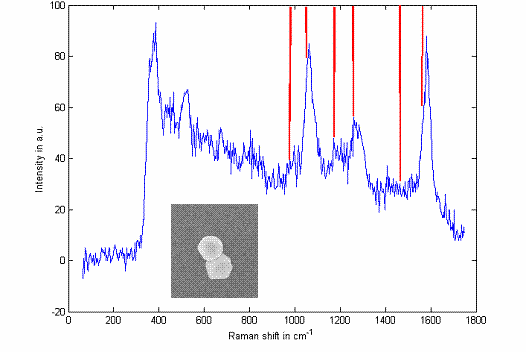

44289-AC5
Toward Gold Nanoparticle Dimers for Single-Molecule Surface-Enahnced Raman Scattering
Single-Molecule Surface-Enhanced Raman Scattering (smSERS) is an extremely sensitive method for measuring trace chemical species. Usually, smSERS is observed by adsorbing a small number of molecules onto random aggregates of colloidal metal particles. When the aggregate is pumped with a laser tuned to its plasmon resonance, highly enhanced electromagnetic fields are created locally and act to enhance the red-shifted Raman signal from a single molecule in close proximity to the metallic aggregate. In addition, a chemical enhancement, which is not completely understood, but is associated with charge transfer effects arising from bonding of the molecule with the metal, also enhances the Raman signal. Both of these processes are necessary to observe single-molecule Raman scattering. We have shown in detail that the electromagnetic enhancement can be controlled by fabrication of metallic bowtie nanoantennas. However, the chemical enhancement has turned out to be quite hard to reproducibly control.
In order to better understand the smSERS effect, it is useful to synthesize a model system, instead of using random aggregates. To this end, gold nanoparticle dumbbells consisting of two gold nanoparticles linked by biphenyldithiol molecules have been synthesized in a collaboration with the laboratory of Chris Chidsey. Exciting the dumbbells with 830nm laser light allowed us to observe Raman signals from individual dumbbells synthesized at ultra-low linker concentrations (see Fig. 1), i.e. 1:5 linker molecule to nanoparticle ratio, as well as for different particle sizes. The observation of spectral diffusion in the spectra along with the ultralow molecule concentration during synthesis strongly implies that the Raman signal originates from a single molecule.
Figure
1: Raman spectrum
obtained from an individual gold nanoparticle dumbbell (individual particle
size 250nm) linked by (probably) a single biphenyldithiol molecule. Vertical
lines indicate expected peak position according to bulk spectra. Inset: SEM of
dumbbell from which the spectrum was obtained. Additional
evidence for the single-molecule nature should be obtained by determining the
dumbbell yield as a function of linker molecule:particle
concentration as well as from using a two analyte technique as suggested in the
literature [E. C. Le Ru, M. Meyer, P. G. Etchegoin, J. Phys. Chem. B 2006, 110, 1944-1948]. However the synthesis of dumbbell structures like
those shown in Fig. 1 is not very reproducible. The variable responsible for the irreproducibility
has not been identified so far, but it is likely related to the citrate ligand
density on the metallic surfaces and the need for the bithiol
to reliably replace or push aside the citrate ligands.
Presently, alternative methods for the
synthesis of the dumbbell structures using click chemistry are being explored.
While synthesis of the gold dimmer
structure is not reproducible, the initial results are compelling and indicate
that under the right conditions, the structure can be made. Certainly, the SERS spectra immediately indicate
that the biphenyldithiol molecule is present, and it is likely that the SERS
signal is indeed due to a single molecule (but not fully proven). With further experimental studies of the
sample fabrication process, reproducible synthesis will be attempted which will
allow for more quantitative smSERS studies.
